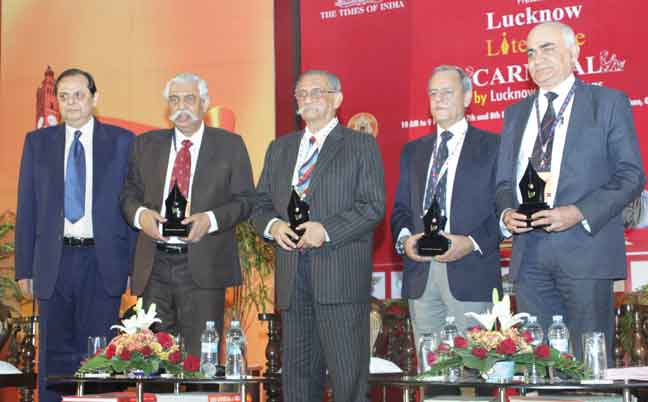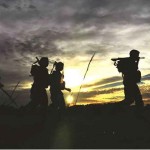The Lucknow Literature Carnival 2013 held from 6 to 8 December for the first time had a full session on Defence Writing. It generated quite a bit of enthusiasm in the journalistic circles. What is more significant is the interaction between many journalists including a leading independent journalist from Lucknow with the veteran defence participants. While the journalists appreciated participation of former defence personnel in such event, they conveyed that they did not have much knowledge of matters military and there were no guidelines as to what should be written about the military and more importantly, what should not be written about the military.
Compare this with the 9/11 terrorist strike at the twin towers in the US where no media was permitted to go within kilometers of ground zero for many days.
Witness the graphic cover over the years whenever Corps level exercises are held, replete with drawings showing how the pincers of the Strike Corps will strike deep into Pakistan. National security is blatantly ignored as well. For example, in the immediate aftermath of the terrorist attack on our Parliament, print media including prominent magazines came out with detailed layout of Parliament, giving which minister and which functionary sits where – an exercise that would only help the terrorists plan the next strike in better manner. Compare this with the 9/11 terrorist strike at the twin towers in the US where no media was permitted to go within kilometers of ground zero for many days. In sharp contrast was the detailed media coverage throughout the 26/11 Mumbai terrorist attack giving full coverage of movement of own security forces, much to the glee of the terrorists and their Pakistani handlers. Not that the so called Home Minister had any sense of security announcing on the electronic media as to when the NSG force would take off from Delhi and how much time they would take to reach Mumbai. Media too blissfully covered which roof (s) the NSG boys were being put down by helicopters.
It is quite obvious that neither the Principal Information Officer of the Government of India is focused on such an important issue nor the Press Club of India has come up with any worthwhile Dos and Don’ts. To top this is the penchant of the politico-bureaucratic-mafia nexus to keep the military down any which way, not to talk of the ISI money that would be flowing in to show the Indian Military in poor light. Even the Prime Minister has acknowledged the existence of “Paid Media”. Not that it is a new phenomenon. MK Dhar, former Joint Director, Intelligence Bureau wrote in his book ‘Open Secrets – India’s Intelligence Unveiled’, “The susceptibility of the fourth estate to the intelligence community had tied our hands down. They are one too many holy Indian cows. Some of them, as described by a senior member of the fourth estate, ‘taxi on hire’. Any paymaster can hire this particular brand”. Editor of a national daily front-paging an attempted military coup through two battalions marching from Agra towards the national capital and stopped enroute (if you please) by the police should be no surprise. He obviously had compulsions; links, skeletons, lick up political bosses, more padding for living beyond means and what have you – ethics be damned.
Interestingly, the Sunday Guardian talked of the story having been fed to the editor by a high profile Union Minister whose relatives are linked to the arms mafia
Interestingly, the Sunday Guardian talked of the story having been fed to the editor by a high profile Union Minister whose relatives are linked to the arms mafia. The editor had cited a “reliable source” while front-paging the coup story – perhaps the same “reliable source” on whose basis the same editor also front-paged news of the retirement of a former army chief even when no such orders had been issued by the government. Interstingly, describing this very editor, former Ambassador K Gajendra Singh had written on April 5, 2012, “………. A top US/ Mumbai corporate interests count, who also disseminates the ruling party’s line and is suitably rewarded by invitations to official dinners etc. Like many others who have prostituted the profession of Journalism, ……. Will probably be nominated to Rajya Sabha.
So much so for ‘free media’ and pressure on media houses, Rupees 100 crores defamation suits et all. The paid media is not only optimized to the hilt, the accompanying arrogance is there for all to see. Witness a 1974 batch former diplomat (another Rajya Sabha hopeful) known to be close to the Prime Minister declaring and repeating during a TV debate on February 3, 2012, that a series of trashy articles against the then army chief published in a daily in Punjab were authorized by the Prime Minister himself, which should not have happened since the case of the said army chief was still sub-judice in the Court of law. Then is the involvement of high profile media personalities in the Nira Radia episode too is an open secret. The sum total is that for reasons both internal and external, arms mafia included that feeds on political unilateralism-cum-favouritism, all aimed at breaking the cohesion of the military.
But while little can be done about those who in the words of former K Gajendra Singh have “prostituted the profession of Journalism”, the military needs to seriously consider the observations of journalists at Lucknow, as mentioned above. Army’s running war correspondent courses is hardly the answer. The Navy says they do run some contact programs but these would be essentially be at the locations of command headquarters that do not meet the holistic requirement either. The Army has a two star officer heading the Additional Directorate of Public Information but their contacts with the journalists are essentially within the national capital and that too in limited basis.
What the journalists of Lucknow were looking at is periodic workshops that would increase military awareness
What the journalists of Lucknow were looking at is periodic workshops that would increase military awareness. With military deployment covering most parts of the country, organizing this on a six monthly or yearly basis should not be a problem. The problem is the British legacy (abandoned by the British themselves decades back) that our politico-bureaucratic nexus is following rigidly for their own convenience and the military having permitted itself to be tied up in knots. Look at the written and unwritten orders of who can talk to the media? Despite the Defence Minister’s empty assertions that the military is not gagged, even Army Commanders are given orders that they will not say anything about China to the media – obviously to shield the pussyfooting response by the political authorities to blatant Chinese intrusions, not placing areas like Depsang and Chumar under command the Army, lack of a National Security Strategy etc. Under such circumstances, how will the politico-bureaucratic hierarchy permit the military to run such contact workshops for the journalists? Yet the military acknowledge the requirement of close interaction with the media in the current and future environment instead of adopting sporadic measures in the hope of projecting the correct image of the military.
In a first of its kind, a serving army Brigadier addressed some 12,000 children from schools of 16 States of India at the 16th Rashtriya Katha Shibir run from 21 to 28 December 2013, though this is an annual feature over the past decade plus. School children of 8 to 18 years of age, accompanied by their teachers are addressed by eminent persons from all walks of life including Governors, Chief Ministers, Government branches like Department of Space, educationists, social workers etc. Though serving Director Generals and senior officers of Central Armed Police Forces have been addressing the children, the Army did so just this first time by deputing a serving Brigadier, presently posted as Deputy Director General (Recruiting) at Bengaluru.
Why the nearest Divisional Commander cannot address children at such impressionable age, if nothing else to make up the severe officer shortages, just goes on to prove that the military is scared to unshackle itself, as a prelude to the nonsensical moral authority of clueless politicians and the unaccountable bureaucracy – a task that should be taken up by the new government in 2014 on as urgent a basis as cleaning up corruption. It would be prudent for the HQ Integrated Defence Staff and the three Services to address the issue in interest of the Military. Obviously, such workshops should precede wide publicity to benefit most journalists including the free-lance and independent ones. Considering the existing constraints of the military as discussed, resistance to change and time visualized to overcome resistance, it is equally important for our various think tanks to also consider running such periodic workshops. Compared to 78 think tanks in China, we have 123 of them and their contribution towards this important issue can certainly make the difference and provide the necessary impetus for the military to join in and take charge.





